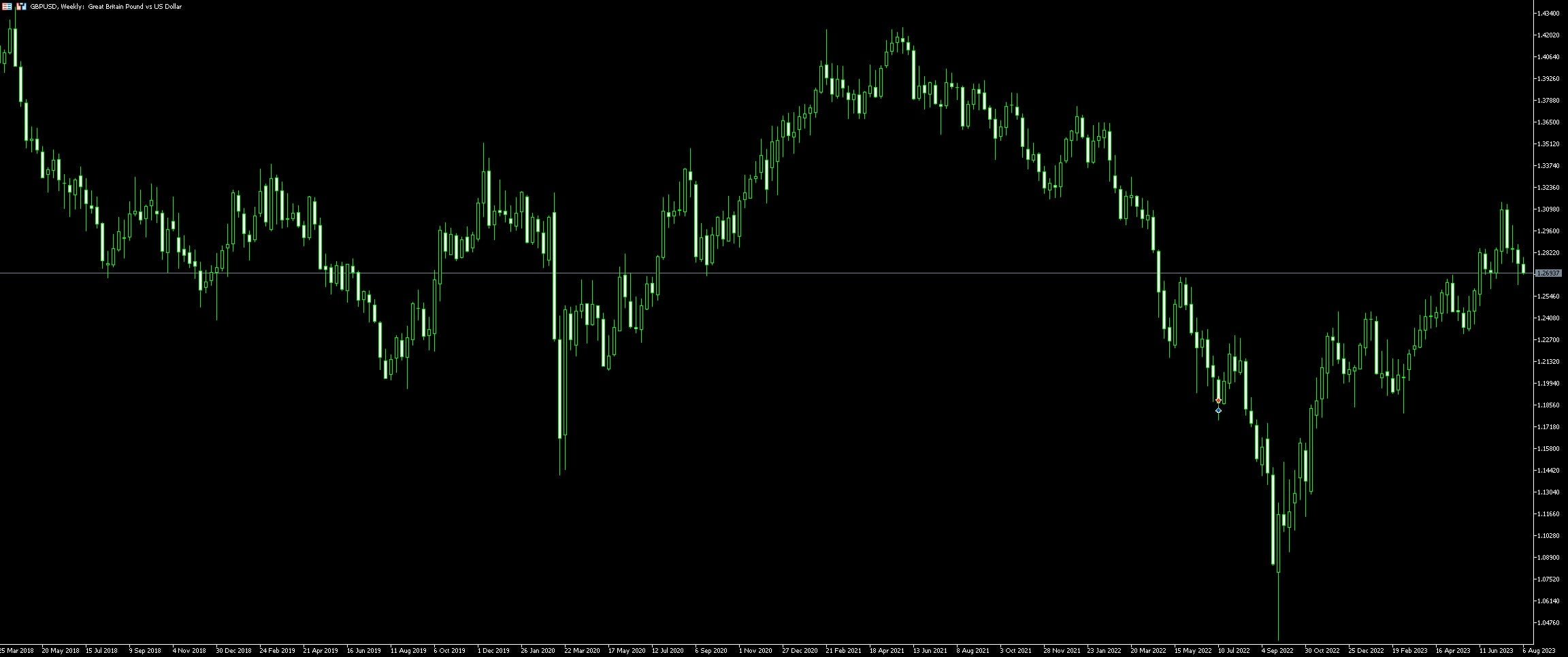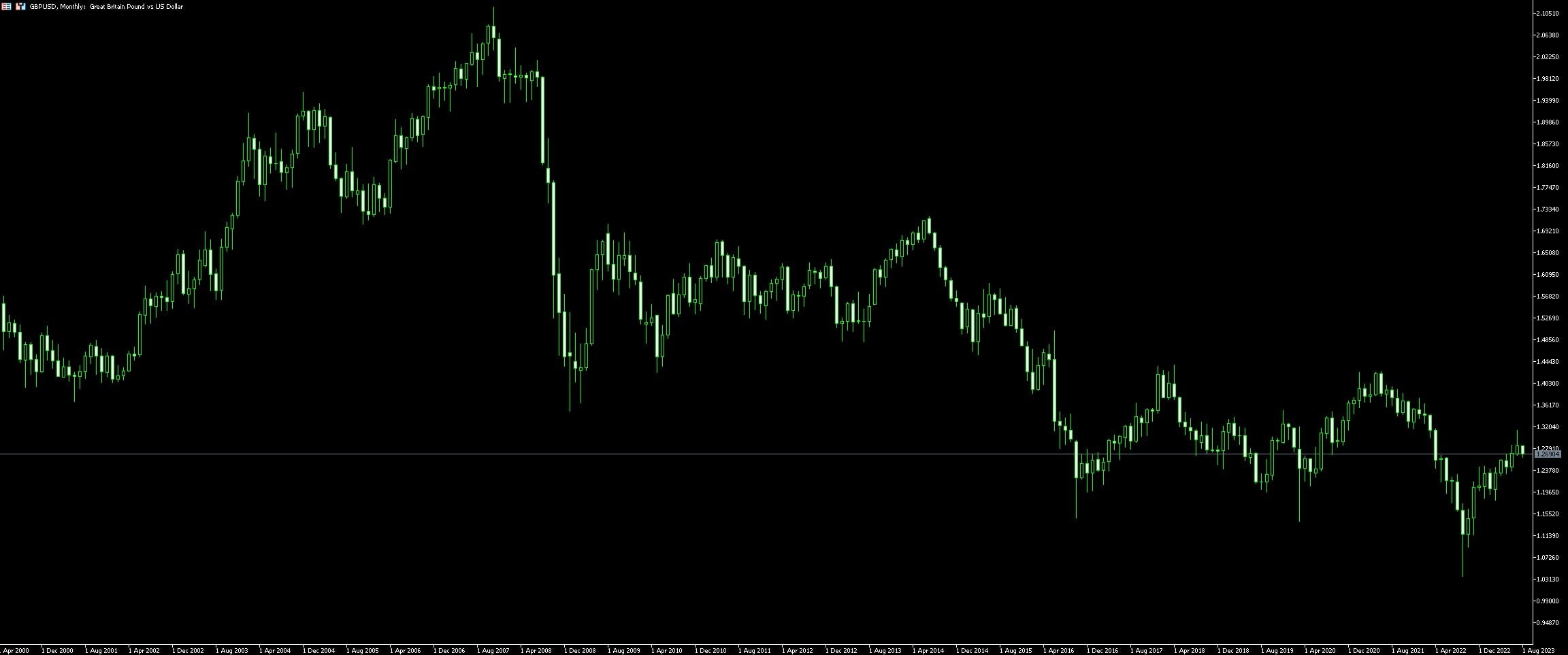Live Chart Of GBP/USD
1. Understanding the GBP/USD Currency Pair
The GBP/USD currency pair, colloquially termed as the “Cable“, links two of the world’s strongest economies – British and American. This pair represents the number of US dollars required to buy one British pound. Many factors influence the GBP/USD exchange rate, such as interest rates, inflation, economic growth indicators, and political stability.
It’s essential for traders to track these indicators to anticipate potential price movements. Since the GBP/USD pair is among the most volatile in Forex trading, possessing a comprehensive understanding of its attributes is crucial. The “Cable’s” aggressive price movements provide traders with multiple opportunities for high-profit trades, but they also present an equally high risk. One popular strategy traders deploy is trading on the news. The cable is particularly responsive to changes in economic data from the UK and USA. By keeping abreast with economic calendars, traders can capitalise on these significant market movements.

1.1. A Look at the GBP (British Pound)
The GBP, or British Pound, is one of the world’s oldest and most widely recognized currencies, reigning from the United Kingdom, inclusive of England, Scotland, Wales, and Northern Ireland. A powerhouse of economic and political influence, it holds a significant position in the global forex market. Its strength is gauged upon various factors like Bank of England’s monetary policy decisions, political events, and even the ever-changing economic indicators such as inflation rates, unemployment rates, and GDP data. These factors make the GBP particularly interesting and sometimes volatile to trade.
In the GBP/USD pairing, the GBP is the base currency and the USD is the quote or counter currency. Thus, it depicts how many US dollars are required to purchase one British pound. Being one of the most heavily traded currency pairs, it offers high liquidity and lower bid-ask spreads, making it a popular choice among forex traders globally. The pair is also known as the ‘Cable’, a term stemming from the transatlantic cables used to transmit currency rates between the London and New York exchanges during the 19th century.
Just like any other currency pair, understanding GBP/USD requires a diligent look at the economic calendars, Central Bank policies and key economic indicators, along with the sentiment in the market. Traders need to keep a close watch on interest rate decisions by both the Bank of England and the US Federal Reserve, geopolitical events, and broader global economic trends. Additionally, staying abreast of any significant shifts or developments in the UK’s economy can provide useful insights for trading the GBP/USD currency pair.
1.2. An Overview of USD (US Dollar)
The US Dollar (USD), as the official currency of the United States, serves as the world’s primary reserve currency. Instituted by the Coinage Act of 1792, its predominance has grown tremendously, particularly post-World War II with the Bretton Woods agreement which made USD the world’s number one international currency. It is used as a standard benchmark for numerous commodities, such as gold and oil, and embodies stability and reliability in the financial markets.
On a macroeconomic scale, several factors drive the USD’s value, such as interest rates, economic growth, and geopolitical stability. For instance, higher interest rates in the US compared to other countries often signal higher returns for investors, fostering an increased demand for the dollar. This subsequently drives the price of this currency upward.
In trading the GBP/USD pair, understanding the factors that influence the dollar’s value is paramount as the USD is the counter currency in this pair. Fluctuations in the American economy, interest rates, and geopolitical stability can cause major shifts in this currency pair’s exchange rate, creating possible opportunities for traders.
Traders should also pay close attention to economic data releases, such as the Non-Farm Payroll (NFP), GDP, and CPI. These economic indicators often lead to considerable market movements and can provide traders with valuable insights about the USD’s performance. Specifically, better-than-expected data generally strengthens the USD against other currencies, while lower-than-expected data can weaken it. Therefore, being aware of these factors can guide traders in making profitable trading decisions involving the GBP/USD pair.
Furthermore, it’s also important to consider USD’s global influence. As the dominant reserve currency, widespread geopolitical events, shifts in global economics, and international crises often cause investors to seek refuge in USD, seen as a “safe haven” currency. This behavior can significantly influence the value of GBP/USD, highlighting another significant aspect to consider when trading this currency pair.
1.3. GBP/USD Relationship Dynamics
Undeniably, GBP/USD is one of the most traded currency pairs in the highly competitive Forex market. To effectively trade GBP/USD, understanding its relationship dynamics is quintessential. The GBP/USD pair, often called the ‘cable’, sees sterling (GBP) as the base currency and the US dollar (USD) as a quote currency. This implies that all trades are executed in terms of the US dollar.
The fluctuation of the GBP/USD, like any other currency pair, is significantly impacted by disparities in economic health and monetary policies of the UK and the US. Factors such as political stability, interest rates, economic growth rates, and even global events significantly influence the currency pair’s market value. For instance, a sharper rise in interest rates in the UK compared to the US will likely see sterling strengthen against the dollar, and vice versa.
Moreover, this pair has a distinctive characteristic of high liquidity during both European and US trading sessions, offering increased potential for profit but simultaneously exposing traders to higher levels of volatility. It is therefore crucial for traders to stay informed about major announcements and events in both zones that might affect currency rates, such as central bank decisions, employment reports, and GDP data.
Lastly, the relationship and correlation of GBP/USD with other currency pairs could significantly affect trading actions. For instance, it has a negative correlation with USD/CHF and a positive correlation with EUR/USD. Thus, these correlations offer additional perspectives for Forex traders to anticipate potential market movements and adjust trading strategies accordingly.

2. Trading Strategies for GBP/USD
Scalping Strategy is a popular approach when it comes to GBP/USD trading. This strategy thrives on the volatility of the pair, where traders aim to profit from small price changes. It involves opening many trades throughout the day, often during prime trading hours to take advantage of higher liquidity. Key to this strategy is understanding market conditions, mainly influenced by data releases from the UK and US, that tend to cause rapid price movements. For successful scalping, one needs to have a firm grasp of technical analysis and be attentive to chart patterns and indicators. Yet, it’s important to bear in mind that though potentially profitable, scalping also carries a high risk.
In contrast, Swing Trading is a strategy more suitable for those who can’t monitor their trades throughout the day. Instead, this approach harnesses price swings in the GBP/USD market. Traders identify ‘swings’ in the market – points where the trend changes direction – and enter trades accordingly. Usage of technical analysis and indicators, such as Moving Averages or the Relative Strength Index (RSI), are essential to identify these shifts. Additionally, staying updated with key economic indicators from the UK and US can greatly aid in anticipating major price swings.
In utilizing these strategies, it’s crucial to maintain sound money management principles. Traders should consider their risk tolerance, leverage and always use stop loss orders to protect against adverse market movements. While trading GBP/USD may come with its unique challenges, the above strategies can equip traders to navigate this pair’s fluctuations and potentially capture profits. Remember, there’s no ‘one size fits all’ strategy in forex trading – each trader must find an approach that aligns with their trading style and goals. Always test your strategy in a risk-free demo account before diving into live trading.
2.1. Fundamental Analysis Approach
In the pursuit of lucrative trading of the GBP/USD currency pair, leveraging the Fundamental Analysis Approach is pivotal. By utilising this approach, a trader dissects the economic fundamentals of both Great Britain and the United States to predict currency movements. A thorough examination of Central Bank movements, inflation rates, the unemployment rate and economic growth rates in both nations is part of this method. Other determinants include political stability and notable geopolitical events.
For instance, if the inflation of the GBP rises quicker than the USD inflation, this dynamic might push the value of GBP/USD higher. Additionally, decisive actions by the Bank of England, such as raising interest rates while the Federal Reserve maintains or lowers theirs, could also generate a bounce in the value of the GBP/USD. However, utilizing Fundamental Analysis is not simply about understanding each determinant in isolation, but to view them holistically to understand how they could interact and influence the currency pair’s direction.
Another element worth emphasising is the role of central banking announcements. Known for their potential to incite market volatility, these are invaluable moments for traders applying the Fundamental Analysis Approach. For instance, a surprise rate hike by the Bank of England could trigger a rapid appreciation in the GBP/USD. Similarly, dovish comments during a Federal Reserve press conference could apply downward pressure upon the USD, causing an upswing in the GBP/USD pair.
Geopolitical events, although less predictable, also radically impact exchange rates. Brexit serves as a stark reminder of this fact. Any trader using Fundamental Analysis would do well to keep a finger on the pulse of global political movements, especially those concerning the US or UK.
Lastly, the overall economic health of the two nations, deduced via their GDP growth rates, paints a broader picture of how the GBP/USD might move. Strong growth in the UK, coupled with faltering growth in the US, would generally be positive for the GBP/USD. Likewise, if the opposite were true, it could devaluate the pair.
Thus, trading GBP/USD successfully through the lens of the Fundamental Analysis Approach is essentially a balancing act, one where juggling several economic and geopolitical factors is part of the process. It requires both a deep understanding of the individual fundamentals and how they interact with each other. A mastery of this approach could unlock a new dimension of trading strategy, offering a rich foundation upon which a trader could base their decisions.
2.2. Technical Analysis Method
The Technical Analysis Method is frequently used when trading currency pairs like the GBP/USD. To put it simply, this method involves analyzing past market data, primarily price and volume, to forecast future price movements. A trader may begin by investigating price charts to analyze price patterns and trends over a specific timeframe. This evaluation can include different intervals ranging from minutes, hours, days, weeks, months or even years, depending on the trader’s strategy and goals.
When using technical analysis, traders often utilize technical indicators and financial tools to improve their predictions. These indicators might consist of Moving Averages (MA), Relative Strength Index (RSI), or Bollinger Bands, amongst many others. For instance, if the GBP/USD pair is showing an RSI level below 30, it can indicate that the currency pair is oversold. Conversely, an RSI above 70 can suggest the pair is overbought. Therefore, the trader may plan their strategy based on these observations.
In addition to these indicators, candlestick patterns such as ‘Doji,’ ‘Hammer’, or ‘Shooting Star,’ are extremely valuable as they can give traders hints about potential reversals or continuations of trends. Bottom line, while the Technical Analysis Method is not infallible, when done correctly, it can significantly increase a trader’s ability to make profitable decisions when trading the GBP/USD pair. It’s thus vital that traders looking to succeed in the market truly understand and efficiently apply this method.
Chart patterns like ‘Head and Shoulders,’ ‘Double Top,’ and ‘Triple Bottom’ can also be instrumental when identifying potential reversals in trends. All these elements play a pivotal role in crafting an efficient trading strategy. These patterns, although may seem complex initially, with consistent practice and application, traders can quickly decipher and implement them in trading decisions.
2.3. Risk Management in Trading GBP/USD
A significant aspect of trading GBP/USD involves a robust risk management strategy. Now, planning for risk management starts with determining the amount of capital you are willing to risk in each trade. A common recommendation is to never risk more than 2% of your total trading account on a single trade, as this technique helps maintain your account’s longevity.
Setting stop losses is another crucial risk management strategy. These allow traders to limit their losses if the market moves against them. The strategic placement of stop losses at strategic positions can mean the difference between a minor loss and a devastating blow to your trading account.
Position sizing should also consider the volatility of GBP/USD. Given the highly volatile nature of the GBP/USD pair, traders often face sudden price swings. Here, adopting a smaller position would help to mitigate risk in times of high volatility.
Risk management in the realm of GBP/USD trading, inevitably deals with the economic indicators from the US and UK. Traders often focus on major economic indicators such as employment rates, GDP and inflation. For instance, if the US data indicates a weakening economy while the UK’s economic indicators exhibit stability or growth, it would influence a bullish sentiment for GBP/USD and vice versa.
Moreover, understanding the effects of political events and central bank decisions is vital since they can cause substantial volatility in the GBP/USD exchange rates. For instance, major events like Brexit or the US Federal Reserve’s interest rate decision impact the currency pair’s direction drastically.
Finally, diversification is an integral part of risk management in trading. While focus on GBP/USD is important, diversifying your trades across other currency pairs can help reduce the potential risks associated with focusing on a single pair.
In essence, successful GBP/USD trading not only emphasizes profiting from trades but also about protecting your investment from unexpected market shifts. At its core, managing risk in trading GBP/USD is about consistently applying proven risk management techniques and being able to adapt to changing market conditions.
3. Best Time for Trading GBP/USD
Trading GBP/USD presents vast opportunities, and understanding the best time to trade is crucial. The most significant trading volume occurs during the London and New York overlap, typically between 07:00AM and 11:00AM EST. This overlap represents a period when both the UK and the US markets are open, leading to heightened liquidity and volatility. Market participants around the globe are actively trading, causing fluctuations in the currency pair value often attributed to economic news releases, central bank announcements or geopolitical events.
The peak activity during the overlap can lead to significant price swings, which can result in either lucrative profits or losses. Therefore, traders need an effective risk management strategy in place during this session.

Outside the overlap, favourable trading times include the early European market session, specifically between 02:00AM and 06:00AM EST. While the liquidity might be lower compared to the NY & London overlap, it’s still substantial enough to enable smooth trading. Major economic data from the UK announced during this period such as GDP, interest rate decisions, employment figures among others, can create meaningful price movements.
Trading GBP/USD during the late US session (late afternoon and evening in the US) can also offer chances for profit, especially around the release of significant US economic indicators. However, keep in mind that reduced liquidity during these hours might lead to wider spreads and potentially higher cost of trading.
Traders seeking less volatility might consider the Asian session (5:00PM – 2:00AM EST), when the markets are quieter due to lower liquidity. Subdued market movement can be especially suitable for carry trades or longer-term strategies.
Understanding these operational hours and considering your own risk tolerance and trading strategy can aid in determining the optimal time window for trading the GBP/USD.
3.1. Trading During London Market Hours
Trading during London market hours offers distinct advantages due to the unique characteristics of the forex market. High liquidity and volatility are two notable attributes of these hours. In the given context of GBP/USD trading, understanding how these factors influence market behavior is essential.
Volatility increases during London trading hours due to a high volume of transactions experienced. This is primarily due to the overlap of trading hours with the New York Market, which typically results in substantial price swings. These price swings can provide ideal trading opportunities for those who have a keen understanding of how to leverage them.
It’s worth noting that the high liquidity associated with London market hours can enable quicker trades at optimal prices. This vital aspect can minimize slippage, which is particularly crucial in forex trading where profit margins may be slim.
Trading strategies such as scalping and day trading could potentially benefit from the heightened market activity during these hours. The consistent influx of fresh market information enables traders to respond promptly to market changes, making quick, real-time trading decisions based on the latest data.
An inherent characteristic of trading during London hours is the possibility of sudden market reversals. Traders need to be vigilant about managing their risks. Setting stop loss orders and applying sound money management principles are advisable strategies for navigating such circumstances.
Additionally, the economic announcements and events occurring in this session, particularly those from the UK and US, can significantly impact the GBP/USD pair. Therefore, keeping a close eye on the economic calendar should be an integral part of your trading routine.
Trading GBP/USD during London market hours requires apt market analysis, swift decision making, and prudent risk management. By embracing a disciplined approach, focusing on technical and fundamental analysis, and remaining adaptable to market dynamics, traders can navigate the waters of currency trading and potentially reap tangible rewards in this high-stakes financial arena.
3.2. Trading GBP/USD in US Market Hours
Trading during US market hours offers a unique opportunity when considering the GBP/USD currency pair. This timeframe, typically from 8:00 AM to 5:00 PM (Eastern Time) is characterized by high liquidity and volatility which can provide potential profit-making opportunities.
Liquidity and volatility are two fundamental concepts in forex trading. Liquidity refers to the ability of a currency to be bought and sold without creating significant price fluctuations. High liquidity correlates to higher trading volume, which can result in narrower spreads and more favourable rates for traders. During US market hours, the GBP/USD pair typically experiences increased liquidity due to active participation of major market players.
Volatility on the other hand, refers to the rate at which the price of an asset, in this case, the GBP/USD, increases or decreases for a set of returns. Trading during high volatility periods may generate higher profits but also poses greater risks. During US market hours, geopolitical events, economic news releases, and other market-moving events can cause significant price movements in the GBP/USD pair. It’s crucial for traders to be aware of these events and manage their risk accordingly.
Implementing a strategy is also key to successful trading. A common strategy for trading GBP/USD in US market hours involves riding the trend. When a clear upward or downward trend in the GBP/USD pair has been identified, traders attempt to buy or sell the currency pair accordingly. This strategy relies on careful analysis of price charts and market indicators, as well as robust risk management techniques to ensure potential losses are kept to a minimum.
Another noteworthy aspect is the Economic Calendar. It provides an outline of important economic events that could influence the GBP/USD currency pair. These events may include anything from interest rate decisions by the central banks, to employment reports or Gross Domestic Product (GDP) figures. Being aware of these scheduled events and their potential impact on GBP/USD allows traders to plan their trading activities more effectively.
In essence, trading GBP/USD in US market hours is about comprehensive market analysis, awareness of key economic events, liquidity and volatility understanding and strategic planning. With careful research, a well-planned strategy, and a disciplined approach to risk management, it’s possible for traders to potentially profit from the trading the GBP/USD currency pair during US market hours.
3.3. Trading in Overlapping Hours
Let’s delve into the notion of trading in overlapping hours. This strategy is particularly useful for the GBP/USD pair due to the overlap of trading sessions in London and New York. Overlapping hours refer to the time period in which both the London and New York Forex markets are open. These hours often see a surge in trading activity due to the high number of market participants.
The overlap period typically happens at 13:00 – 16:00 GMT, providing a window of opportunity for traders to take advantage of the volatility. As GBP/USD is one of the most commonly traded currency pairs, it is during these hours that the currency may experience significant price fluctuations. Consequently, these market changes can offer numerous trading opportunities for astute traders.
However, it’s important to bear in mind that this increased volatility also holds potential risks. Always employ risk management strategies like stop-loss orders or limit orders to safeguard your investments. Furthermore, stay abreast of any overnight news or economic data releases from both the UK and the US that may affect the currency pair.
The overlap of market hours also impacts liquidity, which is paramount for smooth trading experience. Higher liquidity often leads to tighter spreads, and this means lower transaction costs. Such financial environment may be favourable for deployment of short-term trading strategies like scalping.
Combine the fundamentals of the GBP/USD pair with technical analysis to help identify potential trends or market reversals during these hours. Using tools such as trend lines, support, and resistance levels, or other technical indicators, could significantly enhance your trading outcomes in the Forex market.
Consider refining your trading strategy to accommodate the unique aspects of the overlapping hours. The blend of strategic trading and thorough understanding of the GBP/USD dynamics could help optimize your trading outcomes. Remember, the most informed traders often stand the best chances of earning consistent returns.
4. Necessary Tools and Platforms for GBP/USD Trading
- Trading Platforms: When choosing a platform for GBP/USD trading, you need one that offers real-time charts, technical analysis tools, and live news feeds. Some of the industry leaders include MetaTrader 4 (MT4), MetaTrader 5 (MT5) and cTrader. These platforms offer benefits such as fast execution speeds, advanced charting capabilities and the ability to use automated trading strategies.
- Economic Calendar: Trading the GBP/USD currency pair requires staying abreast of economic events that can potentially affect the forex market. An economic calendar, which lists anticipated economic events, their previous and forecasted impacts, and the actual outcomes can be a critical tool for successful forex trading. Traders often react to these economic reports, causing the forex market to fluctuate. Hence, an economic calendar can guide your trading decisions.
- Forex News and Analysis: Given that the forex market is impacted by global events, having a reliable source of forex news and market analysis is crucial. Websites like Bloomberg and Forex Factory provide deep insight into the market, including trends, forecasted movements, and key economic events.
- Charting Tools: To better understand the movement of the GBP/USD currency pair, traders use charting tools. Technical traders utilize indicators such as moving averages, Relative Strength Index (RSI), and Fibonacci retracement levels to predict future price movements. Fundamental traders on the other hand, may use these tools to identify trading opportunities based on economic indicators.
- Automated Trading Software: Experienced traders often use automated trading software that can execute trades on their behalf based on predetermined criteria. Such tools minimize the chances of human error, remove emotional trading, and can operate 24/7, providing the traders with increased leverage over their trading activities.
- Risk Management Tools: Trading in the forex market, and particularly the volatile GBP/USD pair, involves substantial risk. Traders should have risk management strategies in place and use tools like stop losses and take profit orders to mitigate losses and protect profits. This ensures that even if the market moves against your prediction, your losses remain within a manageable scope.
4.1. Selecting a Reliable Forex Broker
A critical component of successful trading is trust; the trust you place in your broker. Hence, this makes the process of selecting a reliable Forex broker paramount to your journey into trading the GBP/USD currency pair. The first step in this process is ensuring the broker is regulated. Lack of regulation means less accountability, and decreased safety of your deposited funds. Search for brokers regulated by trustworthy bodies, such as the Financial Sector Conduct Authority (FSCA) of South Africa.
On top of the regulatory mandate, examine broker’s trading platform and tools. Trading systems vary across brokers, and you need to ensure the platform is user-friendly, stable, and equipped with the tools you require for effective trading. Furthermore, delve into the broker’s transaction cost – no one wants to lose unnecessary money on the expense of trading.
Rounding off the key factors is customer service. Market anomalies can occur anytime, and you may require immediate assistance. Hence, your broker must be available 24/7, swiftly responding to your inquiries or technical snags.
However, the ultimate deciding factor remains your trading needs and goals. A broker that perfectly complements another trader’s strategy might be the wrong fit for you. Research, review, and make an informed choice. Remember to start with a demo account to test your broker before proceeding with the real trading account.
4.2. Navigating Forex Trading Platforms
Understanding the ins and outs of a Forex Trading Platform is paramount to trade any currency pair, including the GBP/USD. While using these platforms may seem complex at first, consistent guidance and practice can transform this intimidating task into a routine process. The very first aspect to acquaint oneself within these platforms is the Market Watch Window. This feature is where the live quotes for any currency pair are displayed and can be customized to suit the trader’s preferences.
Next comes the Navigation Bar, a set of icons intended to offer easy access to functions right at the trader’s fingertips. The most common icons to familiarize yourself with include the ‘New Order’ button, which opens a trade execution window, and the ‘AutoTrading’ button that allows the use of automated trading strategies. Another key feature is the Chart Window where the price movement of the selected currency pair, in this case GBP/USD, is displayed. The Chart Window not only allows visual analysis but also acts as a playground for technical analysis tools.
One would often hear traders mentioning the Terminal Window. This section offers an overview of current open positions, past trades, account balance, and other financial details. For those looking to plan ahead, the Economic Calendar can be a great ally, providing a schedule of economic events that are likely to affect currency pair prices.
Traders should also become well-versed with the application of Orders, these encapsulate Market orders, Pending Orders, and Stop Orders. Mastering the art of placing orders efficiently can significantly impact the effectiveness of one’s trading strategy. Each tool progressively contributes in painting a comprehensive picture of the market scenario, assisting traders to make informed decisions regarding the GBP/USD currency pair. Learning the ropes might take time initially, yet the potential payoff in the confidence and accuracy of placing trades can make the effort worthwhile.
4.3. Making Use of Trading Signal Services
Trading signal services have become an indispensable tool for many who trade the GBP/USD currency pair, whether they be rookies venturing into the trading realm or established professionals. These services provide real-time trade alerts, which help traders make decisions about when to trade, what to trade and at what price. The contents of a typical signal may include the currency pair (in this case GBP/USD), the action (buy or sell), the level to enter the market, stop loss level and a take profit level.
Deciding to make use of trading signal services should not be taken lightly, as they come with both advantages and drawbacks. One advantage is that it allows traders to make trades even without complete knowledge of the foreign exchange market. This comes quite in handy for beginners who lack the understanding and required knowledge. It eliminates long hours of studying the market and discourages emotional trades, as the alerts are based on market analysis.
Another merit is the time-saving aspect of using these services. Traders need not watch the currency pairs all the time to identify trades. Signals pinpoint potential trades, allowing traders to spend time on other aspects like strategizing and risk management.
However, downsides exist. Uncertain signal accuracy is one major concern, especially amongst services claiming an unrealistically high success rate. There’s also the cost factor, as most premium signal services are subscription-based.
When choosing a signal service for GBP/USD, it’s essential to verify their track record and performance. Credible providers usually offer a trial period for users to test the authenticity and efficiency of their service. In essence, it’s important to conduct due diligence before settling on any service. In various instances, combining trading signal services with other trading strategies is deemed the most optimal approach.











